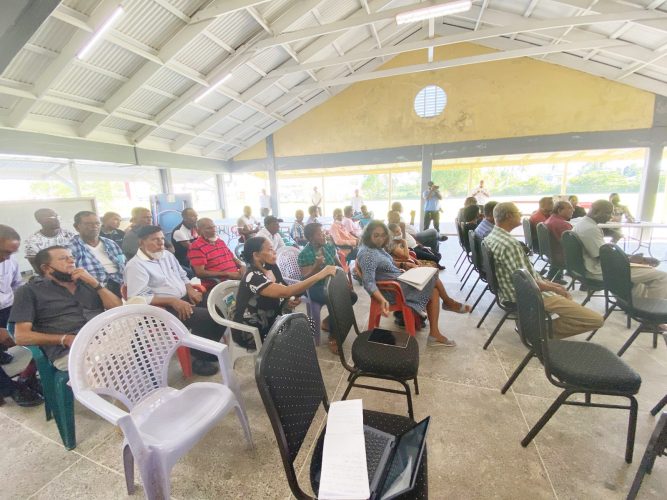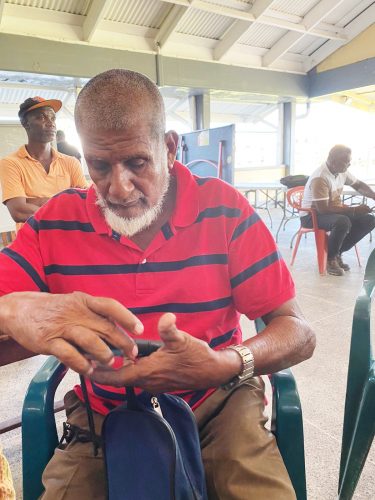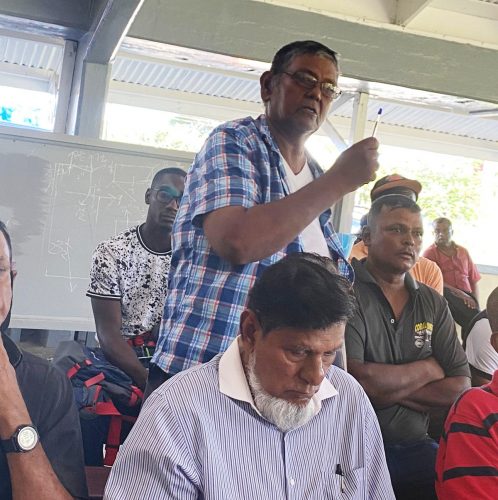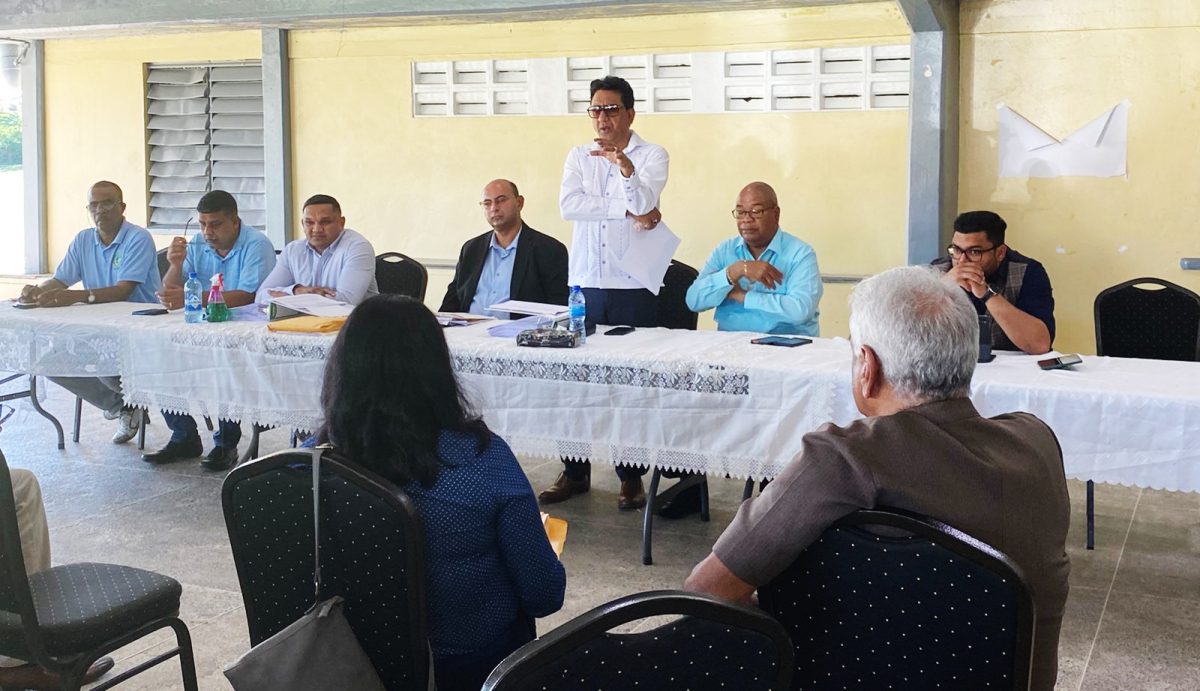During what was called the initial meeting for negotiation, the government on Friday informed persons whose lands fall within the path of the gas pipeline, to be run from the Stabroek Block to Wales, West Bank Demerara that it is willing to pay them between $1 million and $4 million per acre.
However, some residents would only be getting a fraction of that sum which will be determined by the location of the property, size and other factors. The information was related by both Attorney General and Minister of Legal Affairs Anil Nandlall and project lead on the gas to shore project Winston Brassington.
Nandlall along with a team comprising of Minister of Natural Resources Vickram Bharrat, Minister of Public Works Juan Edghill and representatives from the government Valuation Office and Guyana Lands and Survey Commission (GL&SC) met with the affected residents in the Collette Newman Hall at the West Demerara Secondary School.


The meeting, for the most part, was cordial, with the government outlining its plans and the residents raising their concerns both about the project and the acquisition of their property.
The pipeline is expected to be landed at Crane/Nouvelle Flanders, West Coast Demerara and run to Wales on the West Bank of Demerara, where a natural gas liquids (NGL) processing plant and power plant are to be constructed.
The project involves capturing associated gas produced from crude oil production operations on the Liza Phase 1 (Destiny) and Liza Phase 2 (Unity) Floating, Production, Storage, and Offloading (FPSO) vessels.
During his address to the gathering, Nandlall highlighted the timeframe for the project, noting that they are hoping to have the acquisition of the necessary lands completed

before the end of October.
Nandlall told the residents that a total of 73.3 acres of land would have to be acquired and that the lands would be strips of no more than 24 metres wide. He added that the valuation of the land was done by the government valuation officer.
“…we are guided by what he has informed us. For the purpose of valuation, Guyana is divided and valued in accordance with certain factors – urban centres, rural areas, distance from road, distance from sea etc. So we have some broad factors here that guide and inform how they have arrived at this position.
“Based on the plotted route, we are considering the acquisition of 73.3 acres of land – the entire pathway of the pipeline and we have a value attached. Of course, the value is going to vary…the value depends on the location, type of land and size of land,” he related.
Explaining the valuation process and prices, Brassington told the residents that the determination of the amount of lands to be acquired was made by ExxonMobil. He added that they are acquiring enough land for all of the construction equipment needed to lay the pipeline.
“That 23 metres is the total width of where the pipeline would be and the area of construction of the pipeline. In addition to that there are some areas where you would need a wider area because they are doing something called HDD drilling – horizontal directional drilling – so they are actually going deep underneath the ground where we have road and seawalls and come back up,” he said.
Brassington said that the lands were surveyed and plotted by the GL&SC after which it was valued. He said that the lands closer to the ocean are more valuable while backlands would fetch a lesser price.
Brassington, who told the residents that the process started last year, further explained that individual notices were sent to each of the affected persons and that almost all of the lands are unoccupied.
“The valuation of the lands and generally the land value there is between $1 million an acre and $4 million an acre and that is basically the value we analyzed,” Brassington said.
‘Tight timeframe’
Both Nandlall and Brassington told the residents that they are working with a “tight” timeframe, noting that the investors are hoping that they can commence the project by the end of October.
“We are on a tight timeframe. It is our objective to start construction of the pipeline by the end of October. A lot of work had been done to prepare for this…our timeline which is intended to secure the completion of the power plant by the end of [20]24 requires that we start this project by the end of next month. So that the turbines and so for the power plant can be completed and when the project is completed the cost of electricity will be reduced significantly,” Brassington related.
At the end of July, ExxonMobil announced that it made a contingent award of the contract for the construction of the pipeline.
Subsea 7 and Van Oord consortium announced that it has received a “substantial” contract from ExxonMobil affiliate Esso Exploration and Production Guyana Limited (EEPGL) for the gas-to-shore project. Subsea 7 said that it considers a “substantial” contract to be in the vicinity of US$150–300 million.
The company said that the scope of the contract covers the project management, engineering, and installation of approximately 190 kilometres of pipeline, with an associated shallow water portion and onshore approach making landfall to the west of the Demerara River, along the coast of Guyana.
Some 150 acres of land at Wales have been allocated for the project, which is expected to cut power costs by 50 per cent. The government’s power plant is expected to utilise “dry gas” for electricity generation.
The pipeline project aims to employ approximately 800 workers during the peak construction stage and 40 full-time workers during the operation phase.
It will be executed in three phases – construction, operation and decommissioning. It entails three aspects as well – an offshore pipeline which is approximately 220 kilometres of a subsea pipeline extending from new subsea tie-ins at the Destiny and Unity FPSOs in the Stabroek Block to the proposed shore landing, located approximately 3.5 kilometres west of the mouth of the Demerara River; onshore pipeline that is a continuation of the offshore line and extends about 25 kilometres from the landing site to the Natural Gas Liquids (NGL) plant; and the NGL plant and associated infrastructure that will be located about 23 kilometres upstream from the mouth of the Demerara River on the west bank.
Both the Destiny and Unity FPSOs have pre-installed facilities to allow for the export of the associated gas with crude production.
Consensually
Nandlall noted that the path of the pipeline has already been determined and said that government did a survey of the lands that have to be acquired. He added that excesses have been catered for and that yesterday’s meeting was to “discuss” the next step in relation to the laying of the pipeline.
“It is a legal process but we would prefer we do it consensually. So rather than go through the long ordeal of compulsory acquisition, which would require a whole process where we got to put all your names and properties in the official gazette and go through a whole long process if we arrive at a decision and we arrive at acceptable principles and acceptable value for both sides for the portion of land involved, we can simply do an agreement of sale and we move on,” he said.
Nandlall told the residents that while the government was plotting the path of the pipeline, great care was taken to ensure that the least number of private properties was affected. He said that the pipeline path, for most of it, runs along public reserves and public property, adding that only where public lands were unavailable did the government cross over into private property.
The Attorney General explained that the government has a list of each portion of lands that would be required to be taken, the size demarcated and the name of the titleholder. He added that government is not looking at the acquisition of excessive lands but rather only plots that the technical personnel deem necessary for the project.
Nandlall explained that there is a principle in law that vests in every government the power to acquire private lands in the interest of national development. At the same time, Nandlall said that the government has to ensure that the law is being used as a last resort and reasonably.
“That is a principle that will guide the government’s exercise of any power in this regard. At the same time, I hasten to inform you that government uses public funds and we owe it to you and all other taxpayers whose monies we are going to use, to ensure that the government is not exploited. While the government does not want to exploit, the government also must not be exploited in this transaction,” Nandlall related.
He told the residents that he would prefer they broker a mutually acceptable agreement as opposed to the government compulsory acquiring their lands. He noted that the previous laws gave the government the power to take private lands and offer the owners the price based on a 1939 valuation. “That law also said that the 1939 valuation you couldn’t question that valuation that you are going to get in a court of law,” he said.
Nandlall explained that the government changed this law in 2001 to pave the way for the acquisition of private lands at a fair market value. He also informed the residents that under the previous Petroleum Act, the licensee (operator of a particular petroleum project) was given the power to acquire private properties that falls within the path of any oil and gas project.
“We amended that Act to remove the power from the licensee to give it to the Government of Guyana through the Minister responsible for Oil and Gas. Why we did that? Because we felt that a government would be more sensitive to the people’s feelings and will ensure that whatever engagement that is embarked upon that affects their lands and their properties, that the government would be in a better and more responsible position than the licensee to deal with these issues. The licensee will be driven by different considerations – financial and profit will be in the considerations.
“We are a government and we believe that the Government of Guyana will ensure that whatever engagement is embarked upon that is it done consensually and that it is done with the people’s interest being given sufficient consideration and it is against that backdrop that there are so many ministers here to meet you,” Nandlall expressed.
Skewed valuation
Yesterday’s meeting was a result of notices sent to the residents and published in the daily newspapers.
The government notice stated “please be advised that residents of the following communities are kindly requested to make immediate contact with Mr Rajesh Kadarnauth, NDC Chairman, Nouvelle Flanders/La Jalousie (671-1482) by Thursday, 22nd September 2022…”
It named the following persons from Plantation Nouvelle Flanders – Khemlata Anil & Devi Dirpaul, Robert SM Surujbali, Bindraman Ramsnar Etanor, Mohan & Narine Persaud, John N Naraine & Amrick Narine, Premnarine Limited, Ronald Persaud Etanor, Raghunauth Raghu & Sukhlall, Nankishore Singh; Union Village – Harry Naraine, Seekumar Ramphal Etanor, Seenarine Persaud Etanor, Lakenarine Singh; Rotterdam – Mehindra Singh, Sukhananan; Harlem/Mary – Abdul Shakur, Abdul Khalil; Vreed En Hoop – Abdul Nazim, Mohamed R. Rayman; North Half Klien Pouderoyen – K. Ramgobin, Surujdai Itwaru, Harry Prashad; Licence Of Occupancy No. 2905 (state land) – Gregory Samaroo, Rampadratnarain, Dwight Alfred, Vedanand Brijraj; Versailles – Lloyd Singh; Bordeaux – C. A. Whoseley, Stuart Huges.
The affected residents at the meeting said that they felt somewhat blindsided by both the information presented to them as well as the alternatives. They said that they were under the impression that they were invited to a meeting and not a negotiation with the government over the price of lands.
At the meeting, in addition to all the information thrown at them, each of the affected residents was issued a letter from the Valuation Division of the Ministry of Finance informing them of the plot size to be acquired and the cost.
In the case of Abdul Nazim, the government is looking to acquire 3.8688 acres of land that is under cultivation. They are offering him $7,737,600.
Nazim, who plants rice, said that while he is not opposed to the passage of the pipeline on his land, he takes umbrage with the way the situation has been handled. He said that they were not informed of any surveys of the land or that they would be coming to a negotiation.
“Them tell us that we must attend a meeting and now we are here and we hearing a whole different story. Me get 55 acres land and me farming there for over 50 years. Me nah mindful give them the three acre land but what me want is me access just like how me been got um. Me want them give me back one access just like what me have,” he said.
He told Stabroek News that the area the pipeline will fall cuts off his access to his fields. He said that the only way he will agree to sell is if the government provides him with alternative access. He noted that right next to his access point is a government reserve that could have been utilized for the pipeline.
“Although me a got lock, them [government officials] a go in me dam and them a do what them got to do. Them drive 2×4 wood jook down and deh deh and when you ah weed, the weeding machine a knock pon it. Them go in there when me nah deh deh and dem a do what them want and now them want come and tek way that from me. That can’t happen,” he said.
Another farmer, Persaud, told Stabroek News that he cannot give up access to his land and chastised the government for ambushing them.
Throughout the meeting, concerns were raised particularly in relation to access to farmlands and how the pipeline would hinder that. The residents also rejected the valuation of the properties, telling the government officials that they failed to take into account the sentimental and productive value of the properties.
In that regard, Nandlall promised to have each of the affected residents meet with an attorney who could explain the acquisition process and address the concerns they may have. Additionally, he told the residents that they can also retain their own attorneys to guide them through the process.
Another meeting is scheduled, at a date to be announced, to deal with the possible agreements of sale or compulsory acquisition. The residents were also told that they can opt for a swap of land in another area.

